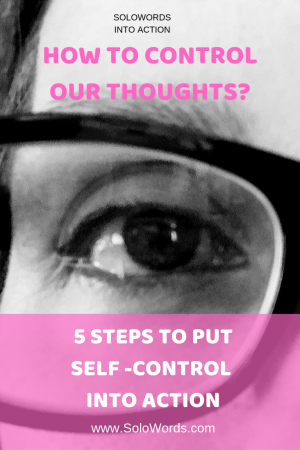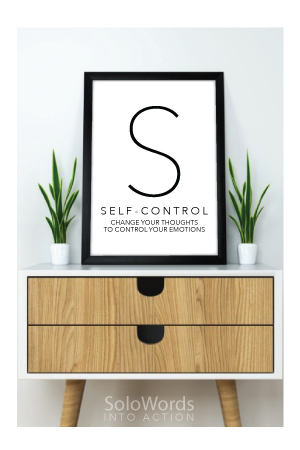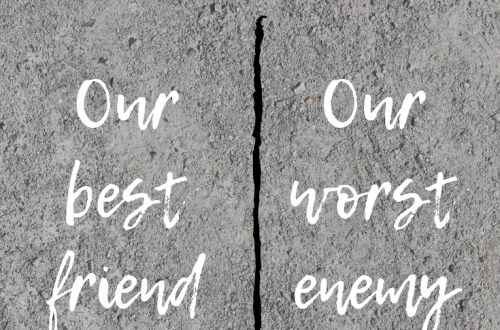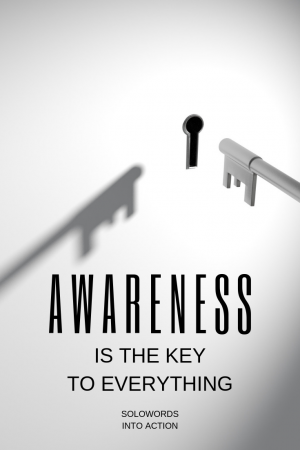
How to control our thoughts? 5 Steps to put self-control into action
How to control our thoughts? This is what I need. It is incredible how sometimes life plays tricks on us. My previous post was about putting the word enthusiasm into action, and I was super excited about it. My whole plan was to work on increasing my level of enthusiasm and transmit it to others. Guess what? I couldn’t. These past few days, I had to deal with some circumstances that made me struggle to follow my plan, and it sucks, but this is life. Isn’t it?
We all know that putting words into action is not easy. It requires desire, determination, commitment, work, effort, sacrifices, and self-control. That is why we use the phrase “easier said than done” when someone gives us advice on how to deal with things.
While reflecting on my struggle to increase my level of enthusiasm, I realized that I let my emotions about some things that happened to me sabotage my enthusiasm. So I thought, if I want to avoid this from happening again, I have to understand my emotions and put the word self-control into action.
What is Self-control?
Here is the definition I found on lexico.com (lexico.com is the dictionary Google shows first when we are looking for a definition)
The ability to control oneself, in particular one’s emotions and desires or the expression of them in one’s behavior, especially in difficult situations.
On a post named self-control-the moral muscle, Roy F. Baumeister explains the self-control meaning as follow:
Self-control is what people use to restrain their desires and impulses. More precisely, it can be understood as the capacity to override one response(and substitute another). It is largely synonymous with ‘self-regulation’, a term preferred by many researchers because of its greater precision. To regulate is to change; namely, change in the direction of some standard, some idea about how something could or should be. Self-regulation thus means changing responses based on some rule, value or ideal.
Most self-regulation occurs in one of four spheres. People regulate thought, such as trying to concentrate or shut an annoying tune out of their minds. They regulate emotion and mood, such as when trying to feel better. They regulate impulse, such as when resisting temptation. And they regulate performance, such as by trading off speed and accuracy, or persevering despite a discouraging failure.
On this post I want to talk about the self-control that regulates thoughts, emotions and mood.
What is an emotion?
While looking for the definition of emotion, I found out that there is not a general consensus among scholars in the literature. However, if we search for “emotion definition” in Google, we get the following from lexico.com
A strong feeling deriving from one’s circumstances, mood, or relationships with others.
Types of emotions:
There are different theories about how to classify emotions. During the 1970s, psychologist Paul Eckman identified six basic emotions that we all can experience during our lives. Later, he added other emotions to his list. More studies suggest that there are more emotions than the ones identified by Eckman. Some even say that emotions are classified by hierarchy. This way, there are primary emotions that break down to secondary emotions, and these in tertiary emotions. For this post, I will only show a list of all the basic emotions identified by Eckman. If you want a more extensive list check out this post from PositivePsychology.com which classifies emotions in positive, negative and neutral.
- Happiness
- Sadness
- Fear
- Disgust
- Anger
- Surprise
- Amusement
- Contentment
- Excitement
- Contempt
- Embarrassment
- Relief
- Pride in achievement
- Guilt
- Satisfaction
- Shame
- Admiration
- Adoration
- Aesthetic appreciation
- Anxiety
- Awe
- Awkwardness
- Boredom
- Calmness
- Confusion
- Craving
- Empathic Pain
- Entrancement
- Horror
- Interest
- Joy
- Nostalgia
- Romance
- Sexual desire
What creates an emotion?
Digging deeper, while reading and listening about emotions and self-control, I also found out that there are six major theories about emotions. One of them caught my attention because it differs from the definition I found in Google. This theory was a Cognitive Appraisal Theory, by Richard Lazarus. According to him, two things have to happen before we create an emotion.
1. External circumstances or a stimulus:
This can be anything that happens to us or that have any influence on us. If the external circumstances are favorable, we get what we call positive emotions. i.e., being recognized for our work will create in us the emotion of happiness and proudness. If the external circumstances are adverse, we will usually get what we call negative emotions. i.e., getting into an argument with someone will create in us the emotion of anger or sadness.
2. Thoughts:
This is the most important thing we should know about emotions according to Lazarus theory. External circumstances do not create our emotions. Our thoughts are the ones who create our emotions. How many times we have said, “I got very mad, sad, or in a bad mood because of what happened to me.” Well, according to the Cognitive Appraisal Theory, we got all those emotions not because of what happened to us, but because of the thoughts we had about what happened to us.” Our interpretation of what happened to us is what creates our emotions.
In other words, our emotions are the result of our thoughts and the interpretation we give to stimulus or external circumstances. Emotions do not derive from one’s circumstances, mood, or relationships with others. We are the only ones responsible for our emotions. Uhg, this hurts, don’t you think? It is much easier to blame our circumstances for our emotions than to blame ourselves for them.
Well, if we believe in this theory, now we kind of know what we need to do to control our emotions. Yes, you got it. We first need to control our thoughts. So here is the big question:
How to control our thoughts? 5 Steps to put self-control into action
Here are five steps we can do to put self-control into action to help us control our thoughts
1. Be aware and conscious of our thoughts and emotions:
A lot of times, our thoughts come to us so fast, like an unconscious reflex, that we don’t realize we have them before the emotion. We typically assume that a external circumstance causes our emotions when, in reality, it is our thoughts that create the emotion. What can we do? Every time we get an emotion, let’s stop and identify what thoughts did we have, or we are having that is creating that emotion. Let’s do the same with our thoughts. Practice by identifying what emotions do we create with our thoughts. By doing this we become aware of how powerful our thoughts are.
2. Understand that we always have two options:
Once we identify the kind of thoughts we have, let’s remind ourselves that we always have two options. Option 1: we keep having the same type of thoughts which lead us to the emotions we are experiencing. 2. If we don’t like the emotions we are experiencing, we can replace what we are thinking with other thoughts.
I love this step. When my kids were younger, every time they had a hard time, I use to say something like this: “You only have two options: keep crying and be all upset or let it go and be happy.” It is amazing how we forget these basic concepts if we don’t practice and remind ourselves to use them frequently.
3. Choose the right option:
I am very sure we prefer to experience positive emotions instead of negative emotions. I prefer to be happy than sad, calm than anxious, proud of myself than ashamed, etc. So if we are the only ones who can change our thoughts, we need to practice choosing the right option as much as possible.
4. Replace our thoughts with a different interpretation of what happened
This is the hardest but most important step. We have to look at everything that happens to us from different perspectives and point of views so we can have a different interpretation of the circumstances. Then, we have to replace our thoughts with the new interpretations.
5. Practice, practice, and more practice:
As I said before, putting words into action is hard, and the only way to be better and master something is through learning and practicing. Everyday, we deal with lots of circumstances that trigger our thoughts. It is our responsibility to understand and control them if we want to control our emotions.
Conclusion
It is essential to understand that we all are a work in progress from the moment we are born until we die. Our mission should always be wanting to learn, improve, and become better human beings. To do this, we have to allow ourselves to make mistakes and fail so we can learn from our own experiences.
This past week I had some tough days because I let my emotions sabotage my enthusiasm. Emotions are so powerful that they can affect the way we live our lives, how we interact with others, what decisions we make, and what actions we take. Emotions, just like attitudes, can be our best friend or worst enemy, and we all have the capacity to control them through our thoughts.
Let me clarify something. I do not pretend to stop my negative emotions from coming with five simple steps. I know it is extremely hard (not impossible, though) to stop our thoughts that create anger, sadness or any other negative emotions from showing when bad things happens to us. My intention with this post is that we get more curious about how our emotions work and understand the power we have when we exercise self-control. It would be good enough if we can start by identifying our emotions and the thoughts that trigger them. This step, I think, will make easier the transition to replace our negative thoughts for more positive ones. What do you think?
Here are two questions for you:
- When was the last time that an emotion sabotaged something in your life?
- What emotion was that?
Here is a link to a podcast that can help you understand and control emotions better. Please take the time to watch!
Easy to download, high resolution image to print at home or favorite local or online print shop in any of the following sizes: 5 x 7, 8 x 10, 11 x 14, 16 x 20 and 18 x 24. To download, click the green bottom bellow.



You May Also Like

Attitude: Our best friend or our worst enemy?
August 28, 2019